Humming Blog |
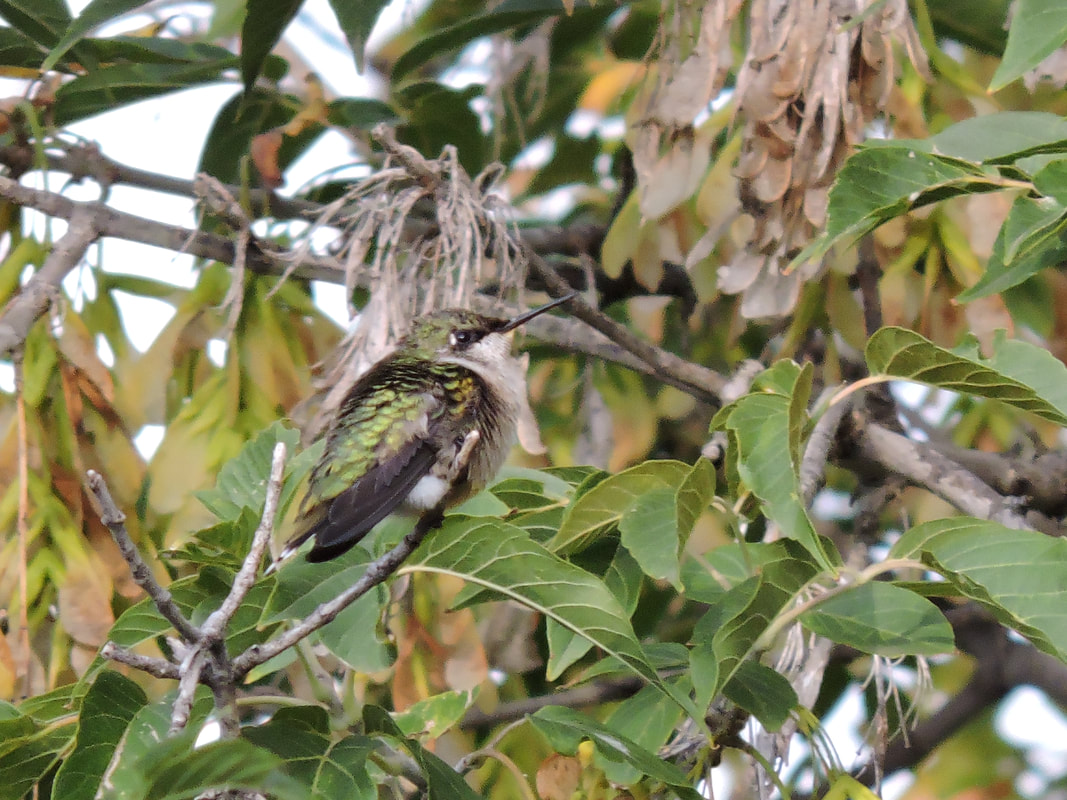 He arrived pretty much the same day as the last few years. We had gone from Winter straight to Summer and we didn't really know what to expect. Slow growing plants were quickly subject to 20 C temps and they bolted from the ground. They were behind schedule 3 weeks earlier, and then the warm ground woke every sleeping perennial in a big hurry. Ziggy, our dominant Ruby-throat hummingbird, showed up right on time. He quickly inspected all his feeders, checked out his bathing fountain, searched out the highest points in the garden, and then guarded and protected his territory for the next 2 months. Other males came and attempted a takeover but he stood firm and defended with everything in him to keep sole ownership of his breeding grounds. Female after female showed up til mid-July, and Ziggy was aware of every one that made an appearance. Each one of them chose a nesting area far enough away from Ziggy's garden, but close enough for the odd long distance feed. July 20th brought our first pair of young hummingbirds. They were greeted by 3 angry males that Ziggy had come to terms with. The young Rubies fluttered and frolicked among the flowers, but learned quickly that others had a bit less playful attitude than they did. They quickly learned to be angry as did all the other young ones that eventually showed up. It didn't take long before the migration was in full swing. Males, females and young started showing up from everywhere, including one lone drifter from well out of territory. The fighting was fierce for a month, but then the numbers started to dwindle. One by one they started to answer their calling and headed towards a place they'd never known. August 29th had 2 lone females in the garden. The next morning one left early, and the other sat in the trees and gave out the odd chirp, expecting a reply from another, but there was nothing but silence. She ruffled her feathers to protect herself from the cool N.W. wind until the sunrise gave her a bit of relief. She fed heavily and then perched. Minutes later she did the same. Her behavior was an indication that she received her personal memo. One more long feed and she was stuffed to the brim. She shook off her lazy feathers, pointed her bill to the sky and waited for one brisk gust from the N.W. to give her a boost. She spread out her tail feathers to help support the added weight she'd just drank, as she lifted off. She did a slight dip towards the ground, but slowly gained elevation. She pointed her bill to the direction of her path, raised high into the sky, and slowly faded to a memory. Here was an image of her blending into the changing leaves. N.E. of Edmonton, Alberta, Canada. August 30, 2018.
0 Comments
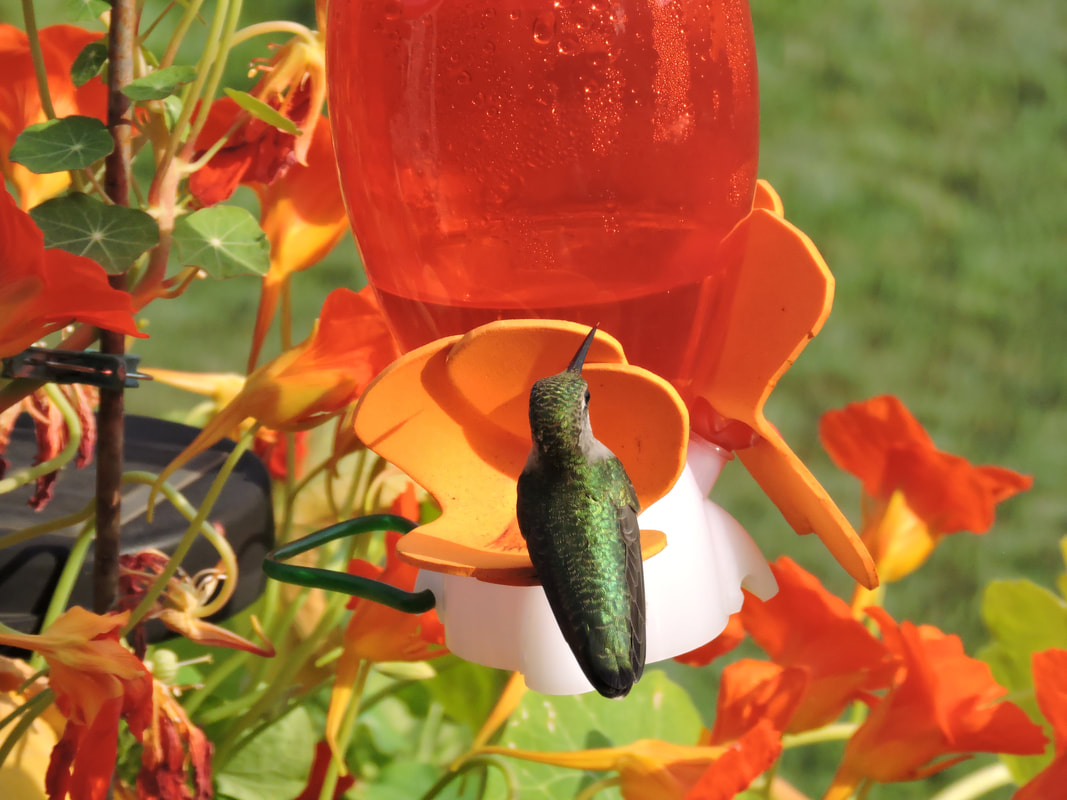 My wife had just arrived home from work mid-day, and very soon after something tapped our front window. She went to check it out, and while she was looking at the large number of House sparrows in the tree, a young Ruby flew up right in front of her. Interesting the way other birds alert us to the arrival of hummingbirds. He sat there cleaning in the Pine tree while she alerted me to it's arrival. It was so tiny. I don't know if I'd seen a smaller bill on a fledged hummingbird before, but he was on his own and acted like an experience preener. We watched as he flew around our house, going to all the flowers that we specifically planted for hummingbirds. Other homes around had flowers, but the list of flowers that are highly attractive, that contain enough nectar to keep hummingbirds returning is much smaller. He must have done the sampling because he kept returning to our garden, but our goal is to always have them graduate to feeders before they leave. It gives them an advantage of getting a lot of food in a short time, and built up fat to assist them in their migration, and hopefully have them return the next year. We know the value of having them learn the feeders before they go, and the strong incentive feeders have in keeping hummingbirds around, but only once they sample the sweetness. After coming and going for about a hour, he rose up to a feeder we had in our front yard. It was like slow motion and felt like several minutes. Our anxiety started to increase as he neared the feeder. It actually appeared like a fish rising towards the surface of the water. He rose up so slowly, forward toward the feeder. We both said, "He's going to try it", and as he approached to within 6 inches, he suddenly lost all courage and flew off. It was so close, that make or break moment, that specific decision in his life that would change his future, and he turned away. We've watched this play out countless times with other young hummingbirds. Some succeed and others not. We wait to see that excitement when they first dip their bill, and see that long tongue lap up the very first drop of life changing goodness. They'll feel a pool of refreshing nectar half ways up their bill instead of a tease at the tip of a flower. I believe that specific moment is an advantage that every young hummingbird needs to increase its chances of survival and migration, even if ever so slight. Here is a young Ruby-throat that graduated to adult food with the help of a training feeder. We've matched the flowers on the feeder to the flower patch it hangs in. Juvenile Ruby-throat hummingbird. N.E. of Edmonton, Alberta, Canada. Early August 2018 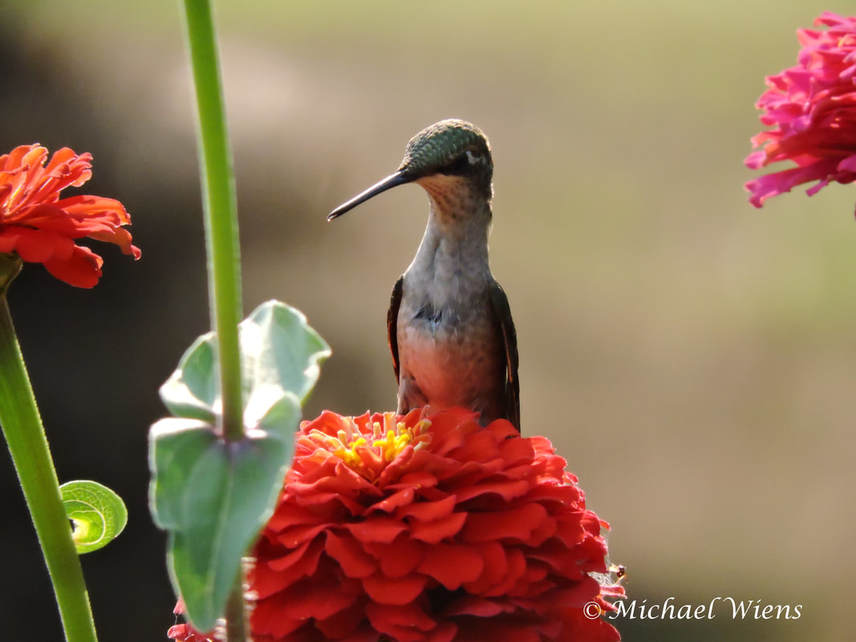 No, it's not a 3.5 oz Canada Goose. This young male Ruby perched on the Zinnia after feeding from it and decide to do a cleaning right there. It's often times real easy to identify a young hummingbird by the location they perch. He sat there and stretched its neck to abnormal proportions to pick away at it's feathers and handsome himself up. It really is remarkable how elastic their neck is, but there's no other way it'd be able to clean in certain areas. Anything the feet can't reach, the neck will stretch and the bill will accommodate. He's learning that man behavior early in life - sitting at the dinner table and doing his cleaning. Juvenile male Ruby-throat hummingbird. N.E. of Edmonton, Alberta, Canada. Early August 2018. 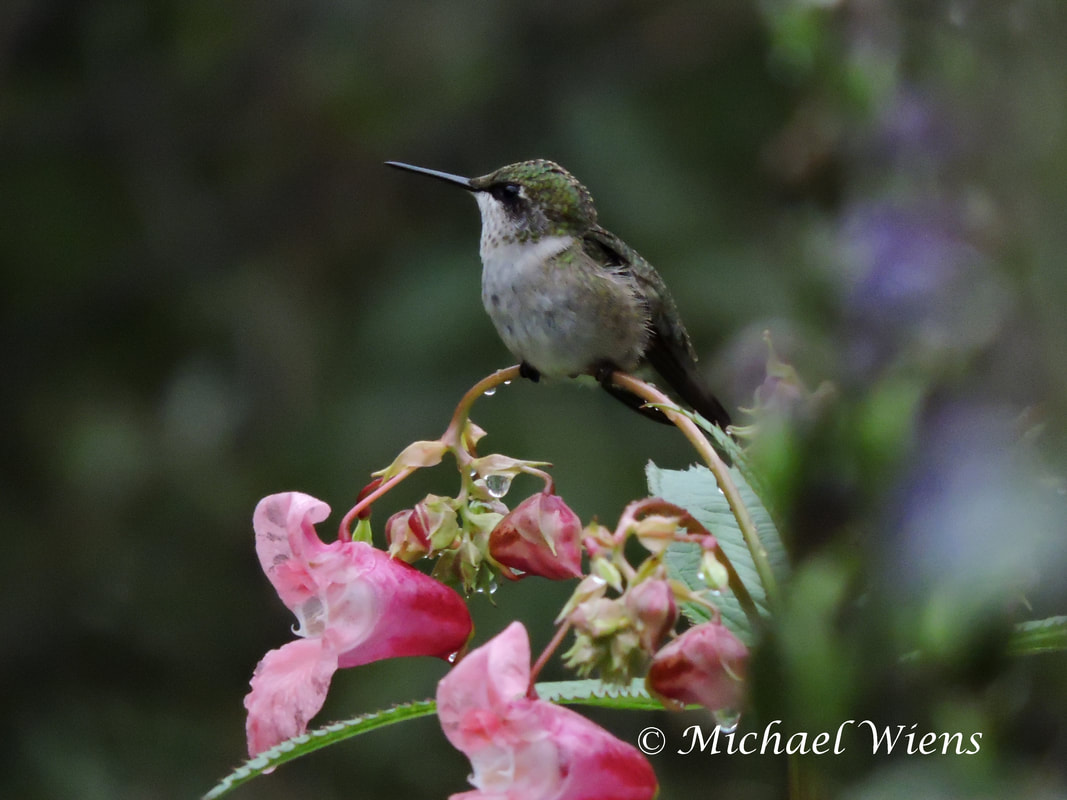 Every year when I start to see hummingbirds migrating south, it seems like it's far too early, but in reality they are leaving right within the times of many migrant birds. It's been a steady flow of birds from the North and it'll continue for weeks to come. My last hummingbird of 2017 was on August 25th, and as of today, August 27th, 2018, I still have at least 5 hummingbirds hanging around, 2 being mothers ready to bring young. These late mothers wouldn't have anything to do with late arrivals in Spring because the 50 day brood cycle of the Ruby-throat would put their arrival time at July 7th, if the young arrived today, which is far beyond the Spring migration times. Could it be an unlikely second brood of a Ruby, or an incomplete brood, forcing the mother to start again? Every year I've noticed that Ziggy or any past males have stuck around until mid-July with breeding behavior. It's only once that mid-July point has passed that they go into a different type of behavior, not resembling breeding. If Ziggy or any male found a mate in mid-July, the possibility of a late brood happening in my garden or anyones in my region would be quite possible, therefore young showing up in late August. I've had recent hummingbird sightings reported to me still in Alberta, including as far north as Peace River, a region not commonly known for many hummingbird sightings. Now for those wondering how long to continue with changing their feeders, this is important. Those N.W. of you are still seeing hummingbirds, and for myself, I have 2 mothers still to bring young to my garden. This tells me that my potential for hummingbirds will be at least 7 more days with my birds alone, and not including those 5 or more days N.W. of me, which means everyone south of me has many more possible days of hummingbirds. Just because your local birds have gone, does not mean the migration is finished. The intense migration forces these tiny birds to travel 50km/day(30 miles), and food is essential to these calorie burning missiles. My suggestion is to leave feeders up a MINIMUM of 7 days after your last birds have left, and 14 -21 days would be even better for the possibility of migrants. This young Ruby sits and protects its own little basket of flowers. N.E. of Edmonton, Alberta, Canada. Mid-August, 2018 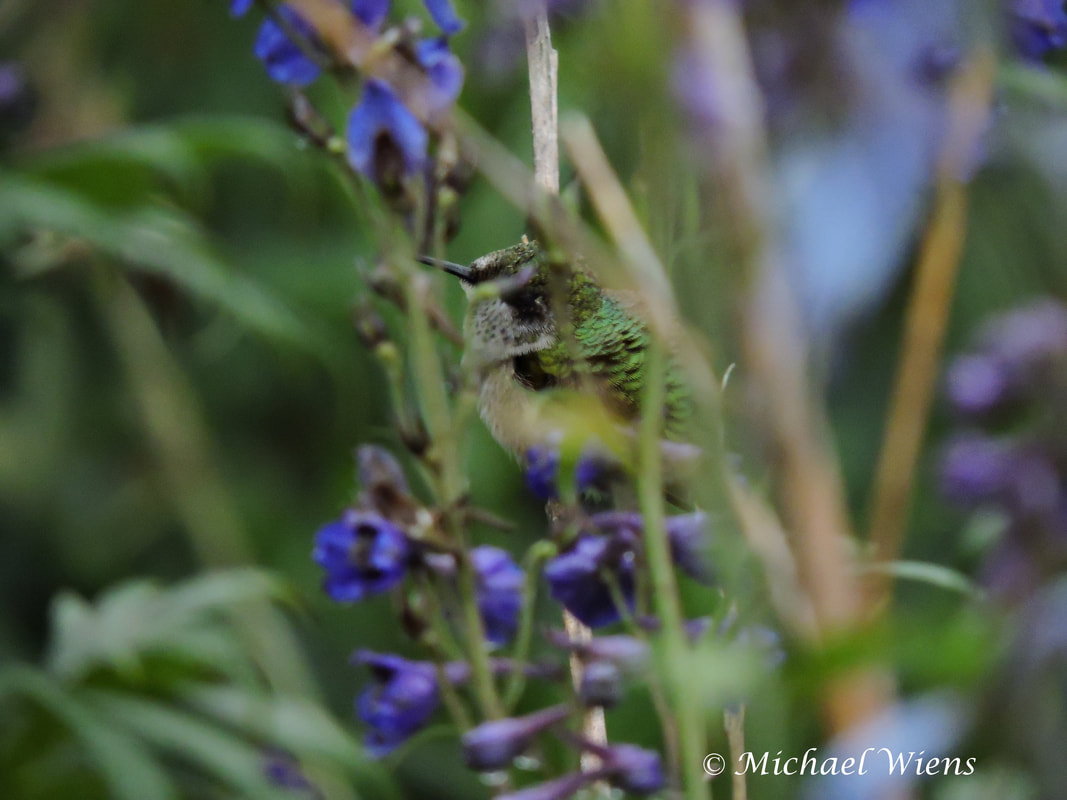 The mature males and a few young males had already established territory near their own individual feeders, but there were still many more young to come. They would have to fight for the available flowers that weren't occupied by another juvenile. This young Ruby-throat chose an old Delphinium stalk to perch on while surrounded by fresh new stalks of blooms. He sat in his little dream land just waiting for the next feed. For anyone who thinks they can sneak up on a hummingbird without them seeing, impossible! You may be able to move slow enough without scaring them, but they see the blink of an eye, the twitch of a finger, and nothing, I mean NOTHING escapes them. With every one of my slightest movements, this little male would catch it and stare for a few seconds. You have no idea just how incredible their eyesight really is. They can spot a perched hummingbird over a hundred feet away sitting in foliage that exactly resembles them. So I once again began to move ever so slowly until I managed a few shots through the foliage. If I didn't know any better, I'd have walked right by and not seen him. This was his patch of flowers that he fought for, and any other trespassing hummer would have to pay the price for intruding, or stay and compete with the owner. I continued after each shot to try for something better, and although he saw my every move, he remained fairly content with me. I eventually got to a small opening in the flowers to catch this little guy in Delphinium Dreamland. I just loved the color that surrounded him as he sat quite content in his reward. One day this youngster would figure out the feeders and take ownership of one of them, but only when the previous owner headed south. For the time being he seemed quite content defending his favorite flowers he'd ever tasted. Captured in early August, 2018. N.E. of Edmonton, Alberta, Canada. Juvenile male Ruby-throat hummingbird. 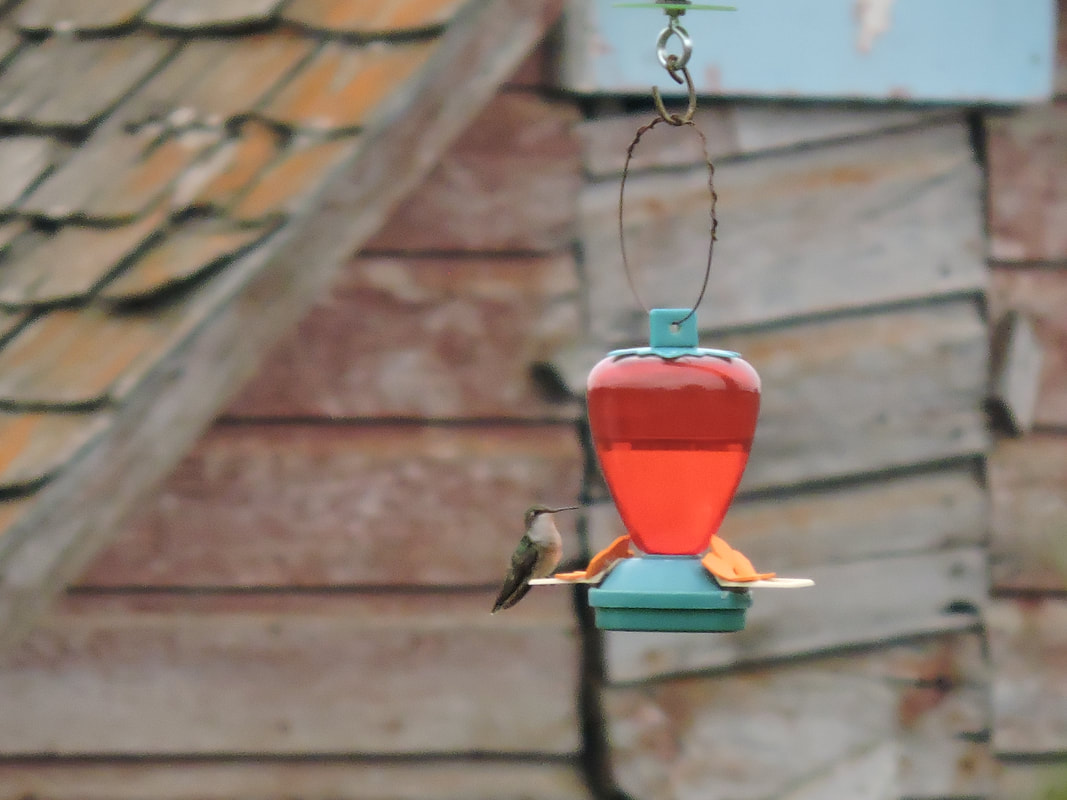 The hard working mother Ruby-throat The hard working mother Ruby-throat This is something you've got to read. I am beyond amazed at what's currently happening in my garden. Most hummingbirds have left our place, with the exception of 1 young that's ready to leave, and 2 females(mothers). It can be really difficult to tell all the hummingbirds apart when you have 10 or more in your yard, but when the numbers are narrowed down to just a few, it's much easier to follow their patterns and habits. About 5 days ago I witnessed 5 birds migrate in the exact same S.E direction from my place, and this is normal, but on that same day I witnessed 3 go in the S.S.W direction. I've seen this before but this time it was different. Wednesday evening and all of Thursday, I saw the same bird(which I previously thought was 3 different birds) heading in that same direction. Here's what's remarkable. This is a mother that I've now determined to be collecting food from our yard and heading to her nest in that S.S.W. direction. She has to fly to a group of trees that's at least one mile away from our place. What's more amazing is that she makes a round trip, to and from that location every 12-14 minutes. She's covering 2+ miles every 12-14 minutes to feed her young. In that 14 minutes is a 30-60 second break at my end and then back to work. This is repeated continuously during feeding time, which can last 2-3 hours at a time. That's about 10 miles of flying EVERY HOUR, not including the chasing and other nonsense that goes on when she arrives. The work she does to raise her young is mind blowing for me. It's an enormous amount of work and stress on such a tiny little body, and this doesn't include the migration journey she still has to take. She shows up to a perch high in a poplar tree, and surveys the area before she drops down to the feeder in the back field of our property. She feeds for about 1 minute before hovering in and among the trees, gathering many insects, and then takes her 30-60 second break. She then goes back to the feeder for another minute to fill up with even more nectar. She leaves the feeder and takes the exact same path around the same trees(unless interrupted), and rises up into the sky and heads back to her nest somewhere in the trees beyond the golden farm field. Each time she returns to her nest she has an insect and nectar mix that she carries back to her young. I took the picture in actual distance, so it's not zoomed in or out. This is the view that I have as she comes and goes. Female Ruby-throat hummingbird. N.E. of Edmonton, Alberta, Canada. August 23, 2018 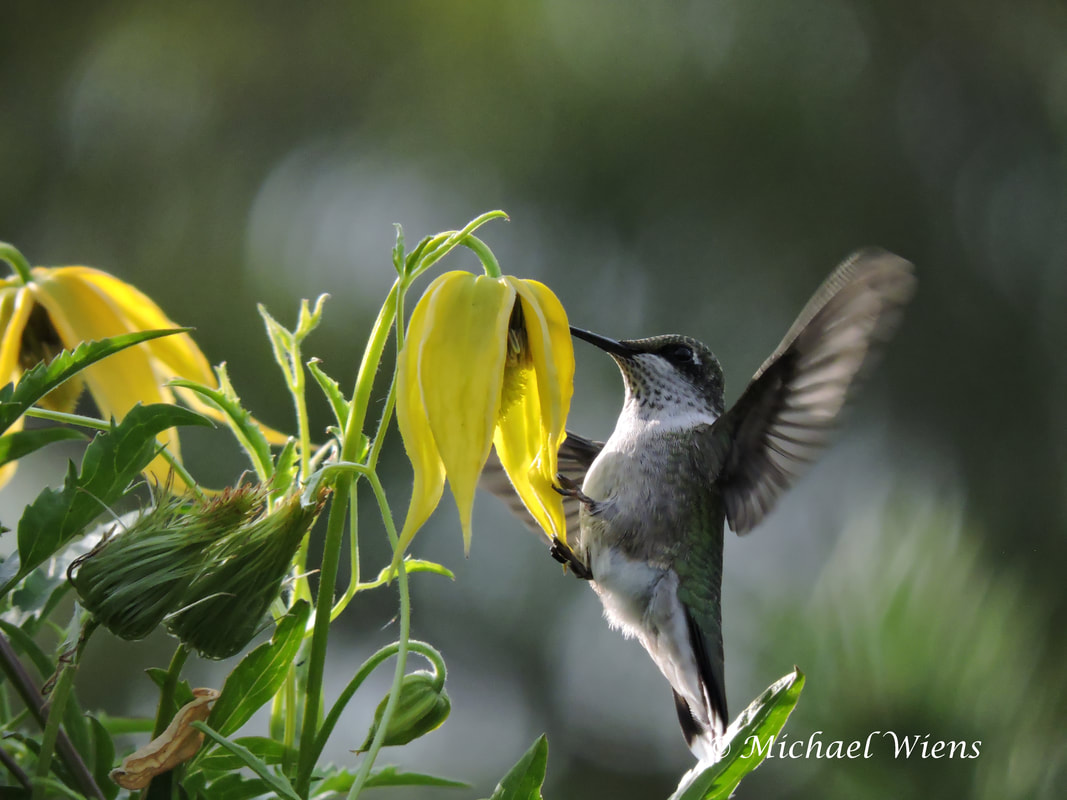 Are we negatively affecting hummingbirds with feeders? This is a moral question that many people ask, not because they necessarily have problems with feeders, but because they sincerely want what's best for hummingbirds. So here's my take on it. Hummingbirds will find food wherever they can. They are very opportunistic, just like most species. They will find sweet sap in a tree, or sugar from fruit in order to get what they want or need. In both these cases there is no benefit to the tree or the fruit, but it's there as a supply to the hummingbirds. If we place feeders out, it's much the same, other than the fact that feeders are extremely abundant across the country. So, one might ask, "Is it hurting the hummingbirds to feed them home-made nectar, or are we taking them away from the flowers they should be pollinating?" We've got about 70 years of feeding history to tell us that hummingbirds are definitely not being hurt from our feeders, nor are the flowers. We'd probably see some kind of evidence by now, but the population seems to fluctuate like many species, with no signs of suffering. Here's the facts with hummingbirds - They love feeders because they are a quick easy source of nectar, but here's the other fact - they will NEVER pass up on flowers. They were built with the desire for flowers, and even though I've seen my hummingbirds choose territory based on feeders, they notice every bloom of every day, and don't neglect to fulfill their purpose. I believe what we are doing is providing them with a supplement to help them fatten up in locations and times where food may be short, and when they are ready to migrate, they'll have the necessary energy to complete the migration without struggle. They also don't need to expend a lot of energy at the time of year they should be conserving it. Here's another thing - Hummingbirds don't eat until obesity kills them. I doubt very much that hummingbirds get up in the morning and question the size of their hips, and say I think I should lay off the sugar. They consume what they need, depending on the time of year and current situation, and NOT by the supply available. The vitamins or minerals required for hummingbirds to migrate, breed, or raise young, has all been provided for them. They will find what they desire and require in order to survive, from one source or another. They won't over eat because we've provided extra nectar for them. They will, however, eat more during the seasons that it's necessary. Up to this time we haven't needed a support group called Hummingbirds with Obesity, because they consume only what they need. They won't overeat out of boredom, and they won't deny their purpose of pollination. This young male Ruby-throat's desire for flowers was very clear every time he made a point to hit every Clematis flower before going to the feeder. Mid August 2018. N.E. of Edmonton, Alberta, Canada. 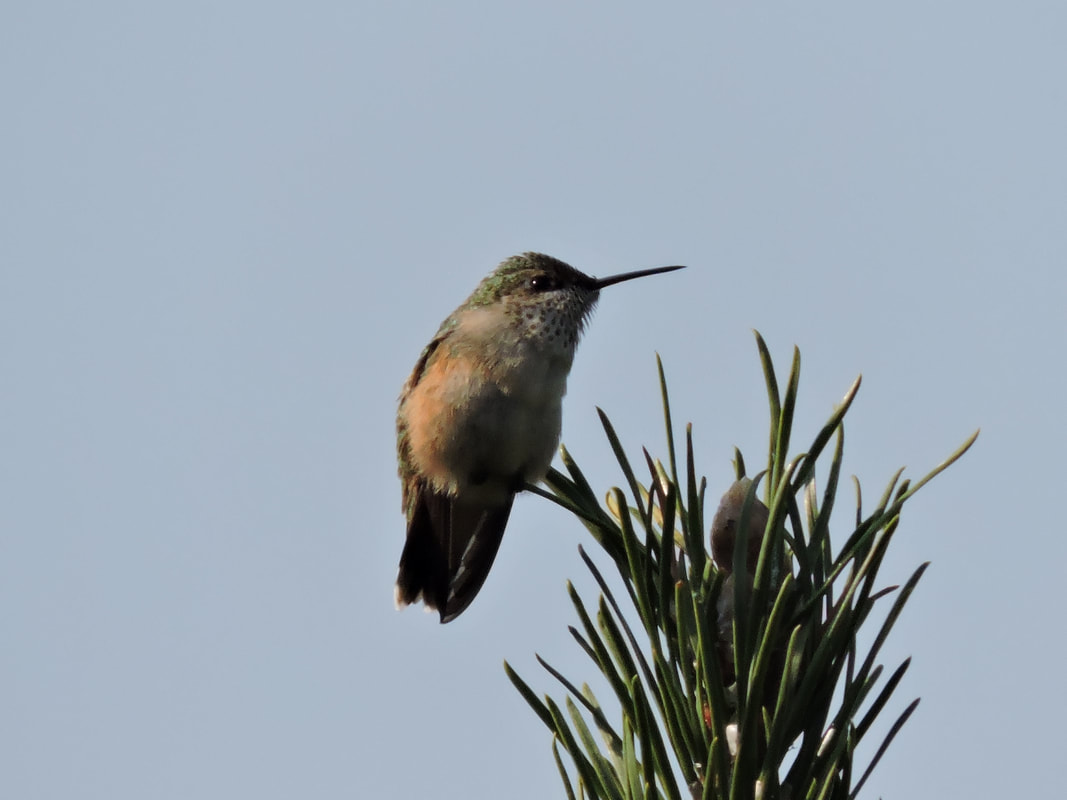 Well here is something that I am so very excited to share. I just spent about 5 hours watching the remaining birds feeding heavily in my yard. There were about 10 Rubies to start the morning, and then I witnessed 5 of them migrate over about 30 minutes. There were still a few that remained including a vocal little one. The sound was a bit unusual for a Ruby, but I really never thought much of it at first. Then when he flared up into the sky and hovered, it appeared to have some buff coloring. I immediately grabbed my binoculars and started to watch for it. There were too many differences from the Rubies to believe it was the same as the others. He did act like Ziggy's kid because he perched on every high point Ziggy did, and acted as though this yard was his. He chased every other hummingbird in sight. This one was a radical! He chased one to the bushes right beside us, and when the other perched, did he ever put on a display. He took a flying start and went up about 50 feet or more in the sky and then did the drop of doom on the other hummingbird. When it neared the ground it created a whistling sound like no Ruby I've ever heard. It was then, I was convinced it was NO Ruby-throat. I got my camera and started taking pics. I managed to get a few pics within 15 feet of him to confirm my thoughts. I'd never heard of Rufous performing this display or making that kind of sound. I still was in disbelief. Could it actually be a Calliope? Calliopes range is about 200 miles or more west of me. They're not like the Rebel Rufous and wander across the country periodically. My guess is that the heavy fires in the mountains have pushed many of them further inland than normal. I'm telling you, this was a moment of a lifetime for me. I get pretty excited when the odd Rufous shows up, but a Calliope? He didn't disappoint. That was a display like I've never seen. He continued this hovering and diving display for about an hour with every hummingbird he encountered. And that whistling dive...Wow! I know the sound isn't a chirp from its bill, but that's exactly what it sounded like as it neared the ground, a whistling chirp! When you're not expecting a rare bird, this one can look very similar to a Ruby at first glance, but it's buff underside, its shorter tail than wings, and green gorget feathers were the dead giveaway. The chattering and personality was something much different as well. Still smiling! Juvenile male Calliope hummingbird. N.E. of Edmonton, Alberta, Canada. August 20, 2018 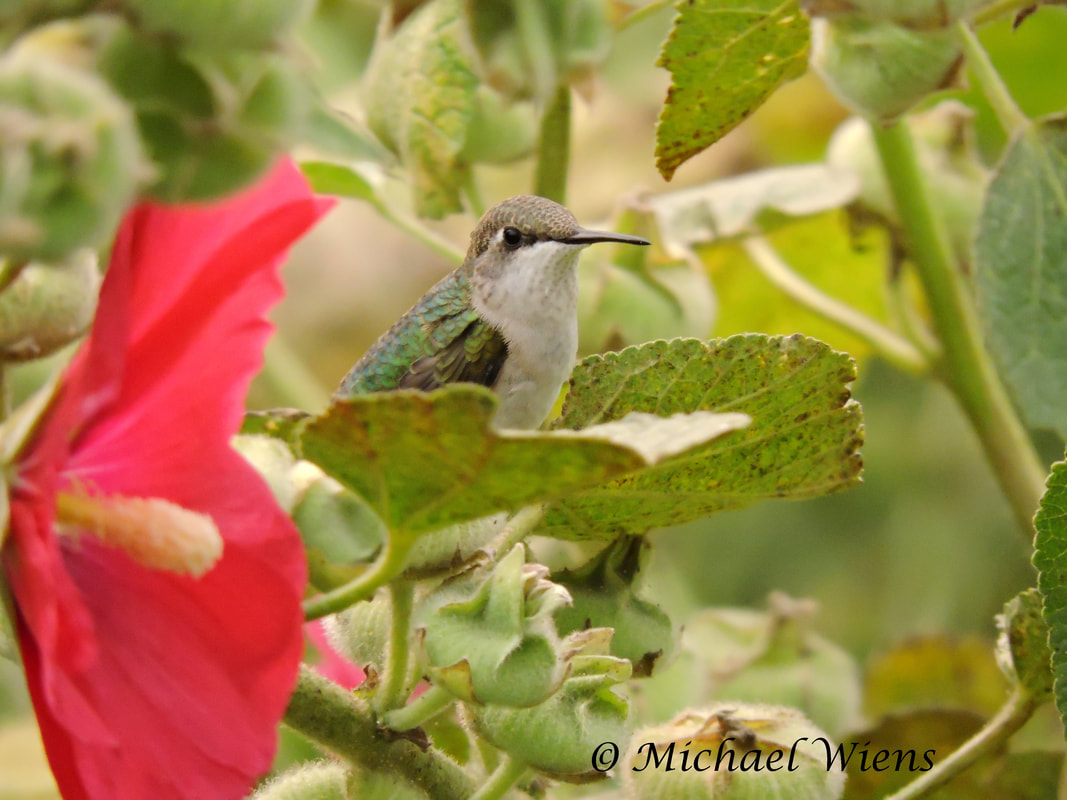 Nature, in its marvelous design has been given a combination of skills and instinct to make it impressive in so many ways. As much as we'd like to believe nature is intelligent, it's much more obedience that makes it operate so perfectly. Could you imagine a species or more deviating from its purpose and doing what it wants instead. The planet would be one chaotic mess. When one piece within the system decides to go rogue, the entire system would be out of sync. However, nature is given "just enough" independence to make it so very exciting and intriguing without making the rest of the system fail. Take a hummingbird for instance. When it sits around your garden, it has options of choosing what foods it wants, whether it wants to chase another hummingbird to the next county or not, or just sit and chirp a warning to that other hummingbird. It's decisions like this that make each bird unique, but if the hummingbird chose to go north for winter instead of south, it would certainly meet its demise. There are things within nature that can't be explained, so we put terms to it like instinct to explain it in an easy term, but instinct is not a simple explanation. By definition, instinct is a powerful motivation to make nature do something that isn't learned, but instead a built in response to some kind of stimulant. Could it be temperature that makes birds go south? Definitely not! Otherwise we'd have birds traveling south with every cold front that passes through. Could it be the how far the sun passes over the horizon that triggers them? It could be, but why was the system created that way? Longer feeding days, longer growing periods for them to complete their cycle within the allotted time? There are many theories, but the entire system is brilliant and complex, with reasons for its design. If we alter something within the environment, there are always tweaks performed to counteract our influence, which then brings it all back into place again. We can over complicate it or think we know it, but the reality is this - nature is extremely obedient. It does what it's told and when it's told. If it rebelled, the consequences would be catastrophic. But this brings me back to my point - Nature amuses and intrigues us daily, it fulfills its purpose daily, and not because it's all very robotic in nature, but because each piece has been given "just enough" independence to react and behave differently to the same event. If we knew the exact move nature would perform at any given time, it would have no intrigue. But personality, behavior, character, or whatever we want to call it, has been portioned out to "Just Enough", to keep us returning day after day and keep us intrigued and amused for a lifetime. This Juvenile Ruby-throat hummingbird chose an unusual place to sit and watch all the others fighting. It had many perches to choose from, but perhaps this reminded it of a nest? N.E. of Edmonton, Alberta, Canada. August 17, 2018. 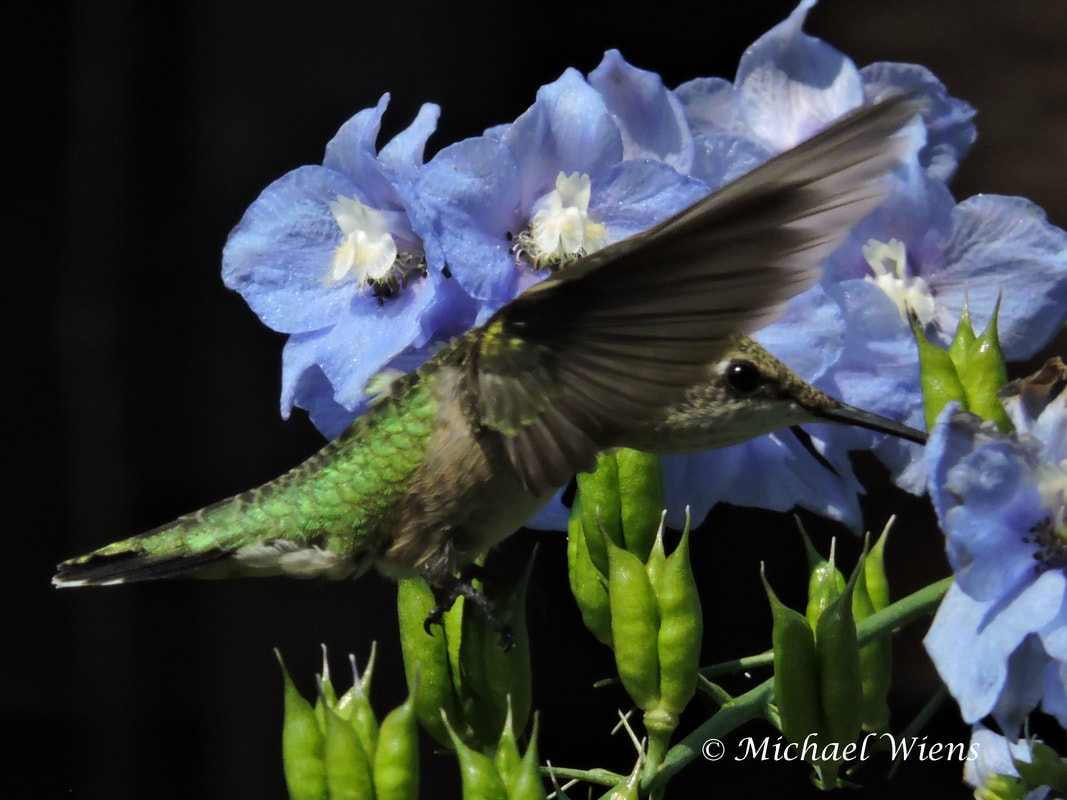 For the last 2 weeks migrant hummingbirds have been showing up in my yard. All the adult males have now left my garden and are are probably a few hundred miles or more S.E. of my place. All the adult female hummingbirds have also left, but behind them are still the angry little children they've left to fend for themselves and fight among each other. Even many of them have left my garden over the last couple days. I've witnessed 4 migrating Rubies just in the last 2 days, and with my yard being dramatically emptied out of hummingbirds, I'm sure I've missed far more leaving. Their migratory behavior is quite a bit different from their regular behavior. They start showing signs that the fighting is less important than just gathering up the layers of fat and storing the energy for what lies ahead. They will travel a whopping 50km/day(31 miles) in flight, and that doesn't inclued the massive leap over the Gulf of Mexico once the get there. The wonders I always have are probably not much different than all the other hummingbirders - Where are they at this moment? How spread out are they? Which Provinces or States are they currently in? Have they all survived to this point with the many dangers they'll encounter? There are many questions once they leave each of our gardens, and it's pretty much out of our hands at this point. We just have to hope and wait til the following Spring to see how things turn out. The image is of a young Ruby feeding on the last few Delphinium flowers, while many of those already spent are now developing seed pods. I love the colors and textures in this photo. N.E. of Edmonton, AB. Canada. August 2018 |
Archives
June 2024
Categories
All
|
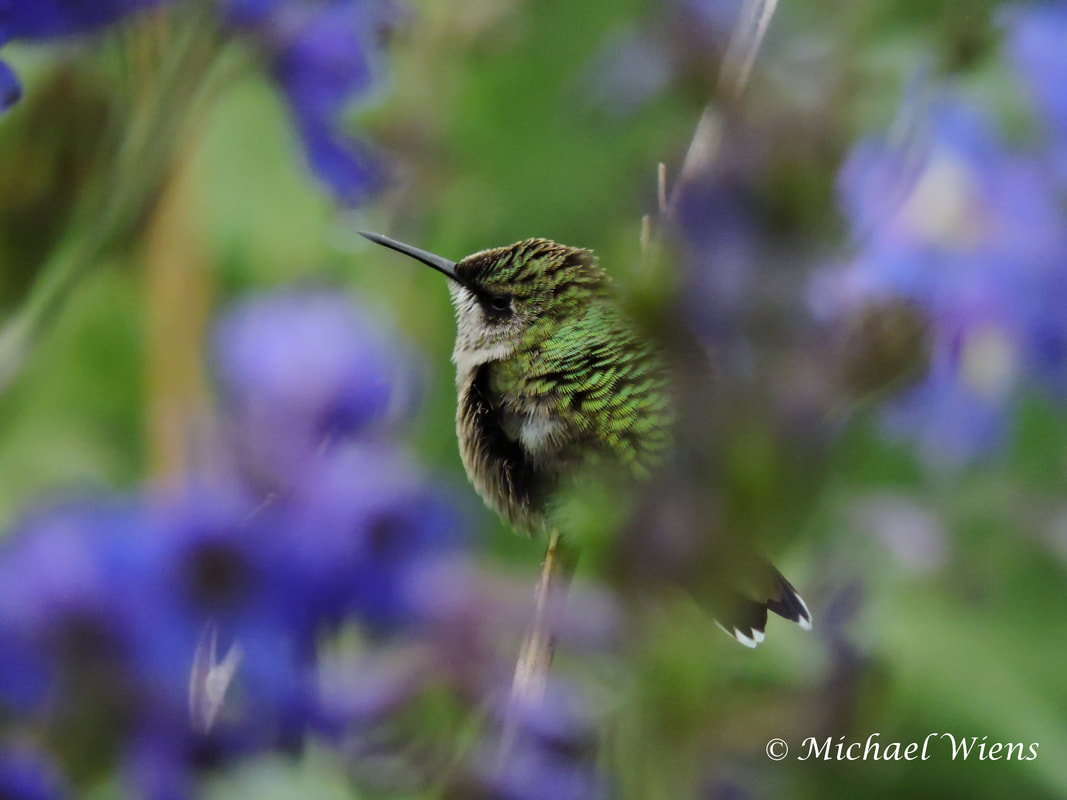
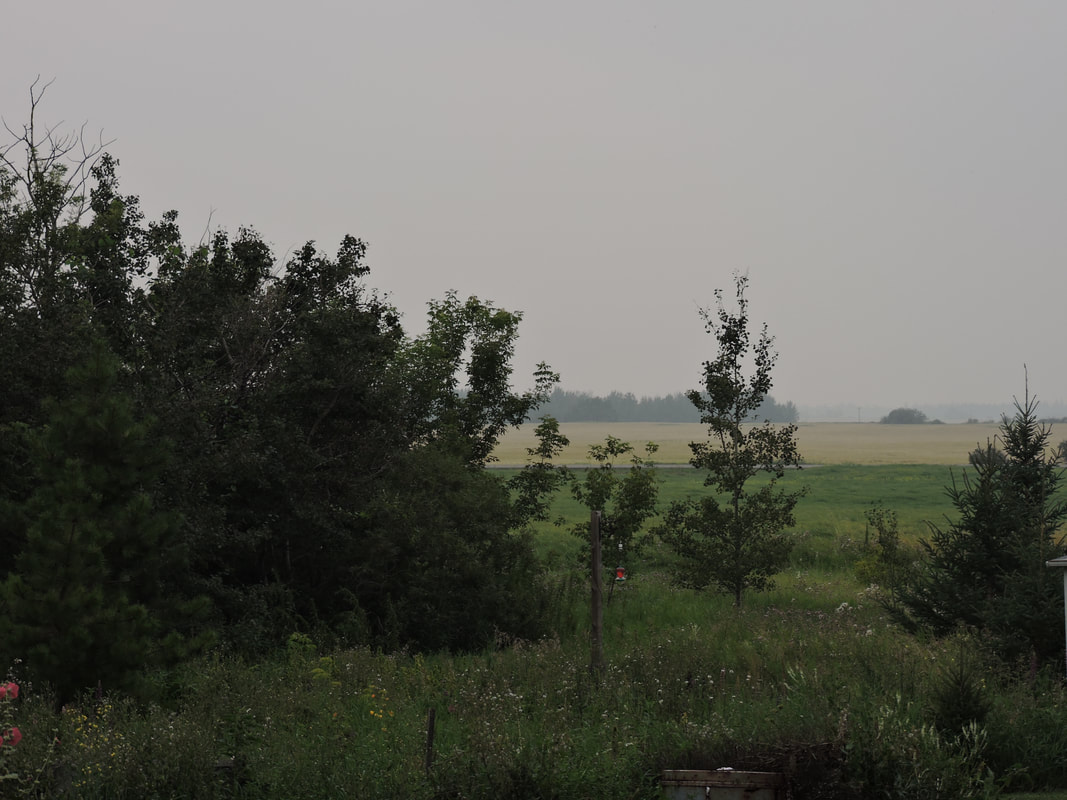
 RSS Feed
RSS Feed
